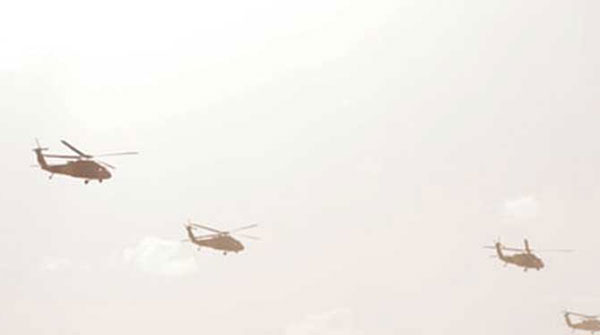Failure to supply Ukraine may prolong the war and raise the risk of tactical nukes
 At the conclusion of the Second World War, or, as the Soviets had it, the Great Patriotic War, the victors, most conspicuously the United States, realized that unless the continent of Europe was quickly rebuilt, states such as Italy and Greece would be dragged into the orbit of the Soviet Union.
At the conclusion of the Second World War, or, as the Soviets had it, the Great Patriotic War, the victors, most conspicuously the United States, realized that unless the continent of Europe was quickly rebuilt, states such as Italy and Greece would be dragged into the orbit of the Soviet Union.
Determined to prevent the dominoes from falling, the U.S. embraced General George Marshall’s 1947 scheme to subsidize Europe’s reconstruction. The Marshall Plan, in official circles the European Recovery Programme, worked. Stalin’s westward expansion was stymied.
Last week, nations supportive of Ukraine’s cause met in London to pledge monies to rebuild that war-ravaged country. The calculus is identical to that of 1947. A strong Ukraine will stymie Putin’s westward expansion. Plus ça change.
Following the end of the Ukraine Recovery Conference, His Majesty’s Government issued a press release. It proclaimed: “(I)nternational commitments to helping Ukraine recover following Russian invasion top $60 billion … one of the biggest reconstruction conference outcomes since the Second World War”. Canada pledged $20 million for climate-change adaptations.
The first problem with HMG’s triumphalist proclamation is that a ‘pledge’ or ‘commitment’ is not a contractual obligation. It is an aspiration. The money may, or may not, materialize. The second is that, while well-intentioned, holding a reconstruction conference in the midst of Ukraine’s 2023 offensive (probably, further offensives will be required to expel Russia from Ukraine) smacks of putting the cart before the horse.
Despite the instability fomented by the Wagner insurrection, Ukraine’s offensive is in trouble. A Sun newspaper video shows the nature of warfare in Ukraine. Firefights resemble those of the Great War:
The incremental liberation of ruined and deserted settlements won’t unnerve battle-hardened Russian troops hunkered down in fixed fortifications protected by minefields – it has been estimated that up to 30 percent of Ukrainian territory has been mined – and other static defences.
Unfortunately for Ukraine’s forces, Russia enjoys air superiority – but not air dominance – over the front. Ukraine is using superannuated Mi-8 troop-carrying helicopters as infantry-support gunships. Large and cumbersome, the Mi-8 is unsuited to this role. Nevertheless, the Mi-8s are flown with skill and courage in support of Ukraine’s ravaged ground forces.
Russian forces, in contrast, can summon up state-of-the-art infantry-support gunships such as the Kamov KA-52 Alligator. Alligator crews use stand-off weapons to stop Ukrainian armoured advances and mine-clearing operations.
Instead of delivering platitudes and promissory notes to Ukrainian President Zelensky, why don’t Ukraine’s allies, including Canada, deliver him 100 state-of-the-art Boeing AH-64 Apache infantry-support gunships? If this is not done, many more Ukrainian tankers and infantrymen will be cut to ribbons before they reach Russian fortifications, much as waves of Canadian, British, French and American soldiers were cut down long before they reached the German trenches during the Great War.
There are other things that could be done. For example, supply Ukraine with hundreds of long-range GPS-guided cruise missiles so the Alligators can be taken out on the ground. The allies are reluctant to supply long-range munitions in case Ukraine uses them to strike deep inside Russia. The net effect of this myopic policy, however, is that Russia can marshal air (and other) assets far behind the lines, secure in the knowledge that they are safe from air attack.
The allies’ caution means that Ukraine has to prosecute its offensive with one arm tied behind its back – much as the U.S. Army had to do in Vietnam under the Johnson administration’s restrictive rules of engagement (intended to deny China a pretext for entering the war). On June 24, 2023, Zelensky requested the allies supply him with the Lockheed Martin MGM-140 Army Tactical Missile System, a bombardment missile with a range of up to just over 300 km.
The Ukrainian army could also increase the intensity of its jagdkampf – small-unit-based irregular warfare – operations. Multiple small teams armed with man-portable surface-to-air missiles (MANPADS) could be inserted into Russian-held territory to interdict enemy helicopters and other low-flying air assets.
Jagdkampf operations are high-risk for those involved. Once located, a jagdkampf team would have to fight its way out of trouble. But the potential rewards are great. Prior to the June 1944 D-Day landings, the Allies inserted three-man commando teams – known as Jedburgh units – behind enemy lines to support the Maquis (French partisans). Historian Stavros Atlamazoglou notes: “Jedburgh teams from the U.S. Office of Strategic Services … the British Special Operations Executive … and the … Free France Central Bureau of Intelligence and Action … parachuted into the region to co-ordinate with … French partisans”.
The bottom line is this: Ukraine lacks the equipment to finish the job. It lacks the equipment required to capitalize on the instability produced by the Wagner group’s short-lived insurrection. While Canada has provided Ukraine with over $1 billion worth of military aid, in practical terms this equates to a small amount of hardware – for example, some Leopard 2 main battle tanks and several hundred Roshel armoured vehicles.
The calculus for 2023 is simple: If Canada and its partners fail to provide Ukraine with enough war material, the war will drag on into 2024 and beyond. The longer the war lasts, the greater the opportunity for Russia to use low-yield battlefield (tactical) nuclear weapons.
Cue World War Three. Unnerved by Wagner, Putin is a loose cannon.
Dr. Simon Bennett directs the Civil Safety and Security Unit at the University of Leicester. He’s interested in the organizational, social, economic and political origins of risk. He has worked with the Royal Air Force and U.K. National Police Air Service on human factors issues. His latest book, Safety in Aviation and Astronautics: A Socio-technical Approach, was published by Routledge in 2022.
For interview requests, click here.
The opinions expressed by our columnists and contributors are theirs alone and do not inherently or expressly reflect the views of our publication.
© Troy Media
Troy Media is an editorial content provider to media outlets and its own hosted community news outlets across Canada.

